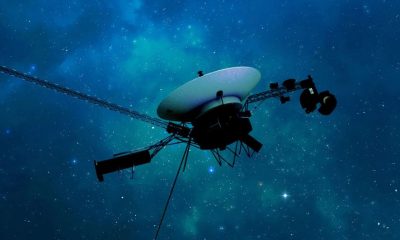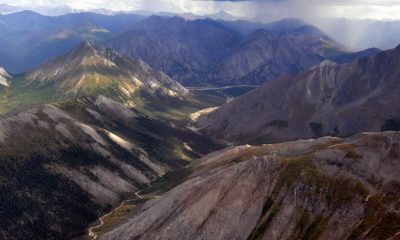News
Museums are at Odds with Her Art, but Can’t Get Enough

Her Art Is at Odds With Museums, and Museums Can’t Get Enough
Inside the Museum of Contemporary Art in Denver, little pieces of Antarctica were melting: cross-sections of an ice core from the continent’s Newall Glacier, each one about the size of a beverage coaster and encased in a vacuum-sealed plastic bag. The artist Gala Porras-Kim watched approvingly during a visit in March, pointing out the air pockets that had started to form.
“The ice cores are an archive of ancient air, because the air gets stuck in the layers of ice,” she said, pointing at the display during an interview at the museum. This particular core, which Porras-Kim had obtained from the National Science Foundation’s Ice Core Facility in nearby Lakewood, Colo., contained ice that had formed some 10,000 years ago, around the beginning of the Holocene period, in geological terms.
Porras-Kim, an interdisciplinary artist who often questions how museums collect material from previous civilizations, was also planning to debut what she called an “ice performance” at the opening of her solo exhibition on March 8: “Gala Porras-Kim: A Hand in Nature.” That night, and at monthly intervals thereafter, an unsealed piece of the core would be placed on a silver tray and allowed to thaw. “The ancient air will get released into this room — a reunion of this old air with the new air, mixing together,” she said, describing it as an “organic de-accession process.”
The exhibition at MCA Denver is the largest museum solo the 39-year-old artist has had in the United States. It follows her busy year of one-person exhibitions, at the U.C.L.A. Fowler Museum, the Leeum, Samsung Museum of Art in Seoul and the Museo Universitario Arte Contemporáneo in Mexico City, among other venues. And next spring Porras-Kim, who is based in Los Angeles and London, will have a solo show at the Carnegie Museum of Art in Pittsburgh.
The artist brings a new and refreshing perspective to some of the most important, and confounding, questions in the field today: how to preserve and display the artifacts of ancient people and Indigenous cultures in prominent museums, and whether to keep them at all or engage in a process of restitution. Her art often unfolds through dialogues with directors, curators and conservators, memorialized in formal letters that suggest ways to restore a sense of spirituality and ritual to objects that have been wrested from their original contexts. In person she has an upbeat, optimistic way of speaking, conveying a persuasive confidence that museums can correct their troubled histories if they are willing to think more like artists.
Often, Porras-Kim’s arguments are at odds with the museum’s imperative to preserve what was taken. One of her projects, “Precipitation for an Arid Landscape,” proposes that remnants of ceremonial offerings that had been dredged from a sacred cenote at Chichén Itzá in Mexico and moved to Harvard’s Peabody Museum be “rehydrated” with rainwater and copal resin, because the Mayan god of rain, Chac, remains their rightful owner. “The rain is still around,” Porras-Kim has said in previous interviews, and who can argue with that logic?
The child of two scholars — her Colombian father is an “old-school historian” and her South Korean mother more “postmodern,” she said — Porras-Kim spent her early years in Bogotá, Colombia, and then moved to Spain. Her family eventually settled in Los Angeles, after her mother had enrolled in a Ph.D. program at U.C.L.A. and Porras-Kim and her father were able to obtain political asylum. Porras-Kim almost followed her parents into academia; after earning a Master of Fine Arts from CalArts, she earned another master’s degree in Latin American Studies from U.C.L.A. She came back to art because, she said, it encompassed so many other fields. “I see museums as a box, a container, that is always changing to fit whatever the collection is.”
The Denver exhibition is unusual for Porras-Kim in that the museum has no permanent collection for her to respond to. So she found another kind of collection nearby, at the Ice Core Facility, where about 25,000 meters of ice are neatly stashed in metal tubes within a giant freezer kept at -38 Celsius. About 2,000 meters a year are deaccessioned to make room for new samples; this is how Porras-Kim was able to obtain the cores for her exhibition.
“I have mixed emotions about seeing them melt,” the facility’s head curator, Curt La Bombard, said when Porras-Kim and I visited the exhibition. “But that’s the point — reaching a new audience that may not have been exposed to what we’re doing in climate science. The last thing we want to do is dispose of these in such a way that they have no value for anybody.”
At the MCA, several of the works present the carefully controlled museum environment as an illusion. Spores gathered from the storage facilities of the British Museum multiplied on an agar-soaked cloth; moisture piped across the gallery from a dehumidifier dripped through a graphite-saturated fabric, making an abstract drawing on a panel placed on the floor.
Porras-Kim also made a site-specific artwork out of a defect in the museum building: the large crack that almost bisects its picture window, which appeared a little over a year ago during a winter marked by extreme fluctuations in temperature. She has titled it “Currents through the fissure from controlling nature,” and has placed a bench nearby so that visitors can sit and examine it.
“The museum is trying to regulate temperature within this box, but the climate doesn’t care. The tension between the two is always going to make this crack,” she explained as we looked out through the glass to the street below. As with the melting ice cores, which are displayed next to the broken window, she is most interested in the idea of air escaping a container. “The title is not so much about the crack, but how the air is coming through,” she said.
Porras-Kim’s art can be described as a new variant of institutional critique, the movement associated with 1970s-era works by artists such as Michael Asher and Hans Haacke; these artists were known for calling attention to the physical and social infrastructure of the art world. She studied at CalArts with Asher, and credits his radical but intellectually rigorous approach (as well as the highly conceptual and philosophical art of Charles Gaines, another of her teachers) as strong influences on her thinking about historical collections.
“How do we move from just prioritizing the material, when there are some things beyond the material that could be preserved better?” she said. “You see it easily when you look at conceptual art, which is immaterial. What are the conservation directions for something that is installed in your head?”
Leilani Lynch, the associate curator at the museum and the organizer of Porras-Kim’s exhibition, says that she was drawn to the artist’s work because it was “digging into the ways in which museums operate, but through a voice and a lens that felt distinct from the history of institutional critique.” This show, she says, is about zooming out from the “microcosm of museum collections” to examine “values of preservation and conservation and the ways in which we are trying to persist as a civilization.” Matthew Robb, a Mesoamerican specialist who organized Porras-Kim’s exhibition last year at the Fowler Museum, appreciated Porras-Kim’s “willingness to confront institutions on their own terms.”
Porras-Kim’s inquiries feel especially apt at a time of increasing self-scrutiny by museums, as they navigate calls for restitution and, in the United States, new federal regulations around the display of Native American cultural objects. “There’s a great deal of anxiety that surrounds institutions, particularly since the pandemic era,” the cultural consultant Andras Szanto, the author of a book on the future of museums, said. “It makes this kind of work feel very urgent because museums themselves are feeling their way and trying to arrive at the right balance. For an artist to be part of that conversation, but with nuance and complexity and not just landing the cheap shots, is a very welcome thing.”
Her suggestions to museum staff, however, are sometimes at odds with the new directives to return objects to their geographic places of origin. “Most of the museums I’ve worked with have a singular, Western point of view,” Porras-Kim said. “It’s not as simple as saying we can copy-paste backward and just return something.”
Back at the museum, the ice cores were shrinking in their plastic bags; after a few hours the pieces were about the diameter of a hockey puck, and surrounded by a froth of air bubbles. “One of the hardest parts of this has been to let the ice melt, because it hasn’t melted in 10,000 years, but it’s not about the water — it’s about the air,” she said.
“This is a way of thinking about how the air, which we think has no age because it’s around us all the time, has been collected and preserved,” she told me. “There are some things that, once the vapor seal of history is opened, you cannot put them back.”
News
Is now the right time to invest in gold as prices have cooled?
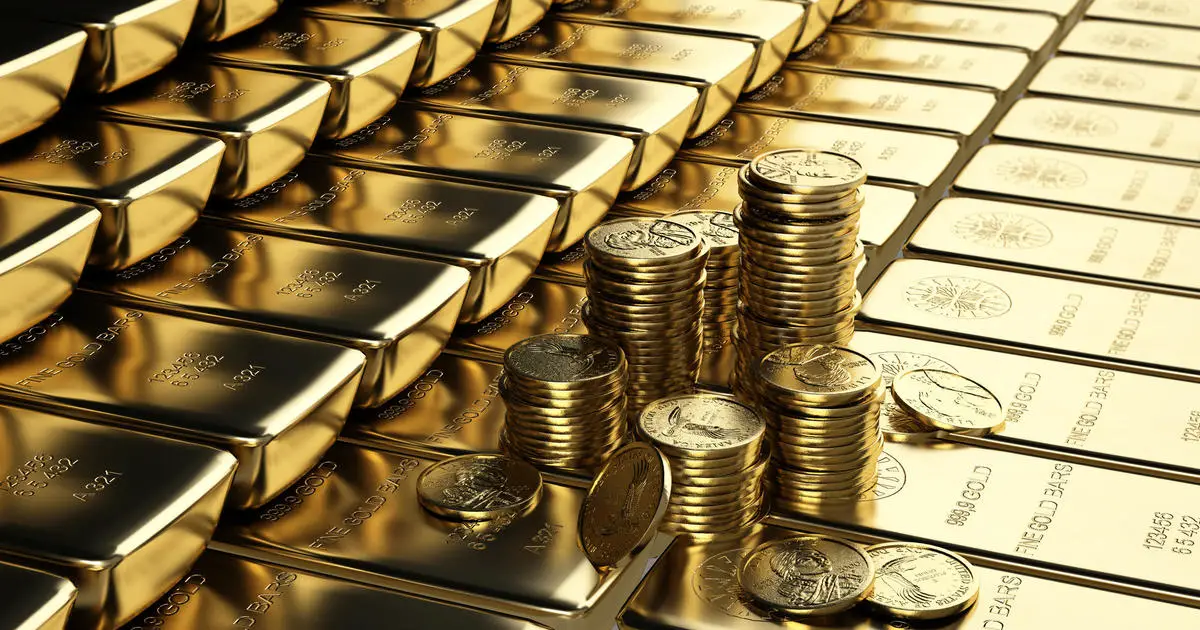
The price of gold has climbed to record highs recently and has remained strong through much of April. And, that growth continued until the precious metal traded at around $2,390 per ounce on April 19, 2024. But since, growth in the price of the precious metal has cooled, with gold’s price now hovering around $2,300 per ounce.
This lull in gold’s price may represent an investment opportunity.
In general, investing is centered around buying assets when prices are low and selling them when prices are high – generating a profit on the difference between the two. So, considering the declines in gold’s price over the past few days, now may be the time to make your investment. But is buying gold during this lull in prices really a good idea?
Compare your gold investment options among leading brokers now.
Gold prices have cooled. Should you buy in now?
With gold’s price down from recent highs, you may be wondering if now is the right time to buy in. There are several reasons the dip in gold’s price may represent an opportunity to buy. Here are some of the biggest:
Prices may rise again
If looking at a gold price chart shows anything for certain, it shows that changes in the overall growth of the medal come in fits and spurts. Periods of price growth are typically followed by periods of declines and vice versa.
But with inflation rising in recent months – and with gold’s reputation as a safe-haven asset that can hedge against inflation – it only makes sense that the price of the precious metal will eventually start to head up again in the future. While attempting to time that directional change may be tricky, buying the precious metal while the price is down gives you the opportunity to take advantage of any upward movement that may be ahead.
Add gold to your portfolio now before prices have a chance to rise.
You may be able to make a quick profit
Gold isn’t known as an asset in which you can earn a quick return, but in today’s market, that may be the case. Don’t forget that in January, gold was trading at just $2,000 per ounce. And, by mid-April, the commodity’s price had climbed to around $2,400 per ounce. That’s about 20% growth in a matter of months, much of which happened since March 1 – an impressive climb for any investment asset.
Perhaps more importantly, gold’s price growth through the beginning of 2024 shows that the commodity doesn’t have to be a buy and hold style investment that you keep in a safety deposit box or precious metal depository for years to come. There’s also the possibility that the commodity’s price could climb further ahead, making it a compelling way to potentially generate a quick profit.
There are other benefits of investing in gold
There are other benefits of investing in gold that have little to do with the price growth seen thus far in 2024 – or the lull in prices seen over the past couple of days. Those benefits include:
- Inflation protection: Gold has long been considered an inflation hedge, and for good reason. When inflation drives the prices of consumer goods and services up – and the value of the dollar down – gold’s price tends to rise. So, it could be used to maintain the value of your portfolio during inflationary economic conditions. That’s important in today’s economic environment as stubborn inflation continues to weigh on the value of the dollar.
- Portfolio diversification: Gold’s price doesn’t always move in the same pattern that bonds or stocks do. So, mixing a reasonable amount of gold into your portfolio (up to 10% of your portfolio assets) as a diversifier could protect you from losses should one or more of your traditional portfolio assets fall in value. “If you have less than 5% – 10% of your net worth in commodities & FX (forex), you should absolutely consider adding exposure to gold and other precious metals,” says Vijay Marolia, money manager and managing partner at the wealth management firm, Regal Point Capital.
The bottom line
Gold’s price has fallen from recent highs – which may represent an opportunity to tap into growth ahead. However, gold isn’t simply a “buy while it’s low and sell while it’s a high” kind of investment opportunity. The commodity can also protect your portfolio from the stubborn inflation we’ve seen thus far in 2024 while acting as a diversification tool that could increase your risk-adjusted portfolio returns. So, consider adding gold to your portfolio today while it has the potential to grow in value.
-

 News1 week ago
News1 week agoKevin McCarthy, former House Speaker, seeks revenge
-
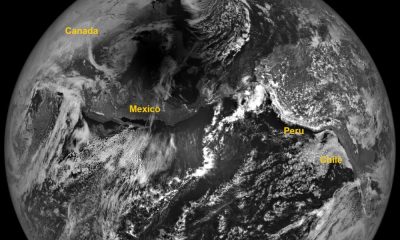
 News2 weeks ago
News2 weeks agoAdditional Perspectives on the 2024 Eclipse: Views from the Moon and Earth’s Orbit
-
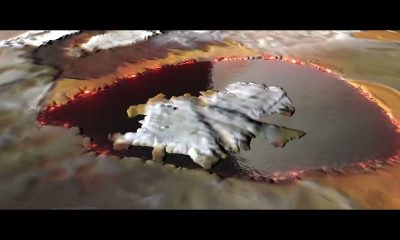
 News1 week ago
News1 week agoJuno discovers massive lava lake on Io
-
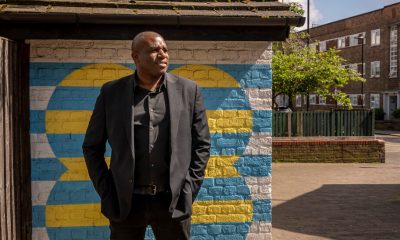
 News1 week ago
News1 week agoPossible Future Colleague of Trump: David Lammy, a Close Associate of Obama
-

 News2 weeks ago
News2 weeks agoKnowing the Magnetic Field of an Exoplanet’s Star is Essential to Determining the True Size of the Exoplanet
-

 News2 weeks ago
News2 weeks agoHouse speaker receives additional request from GOP member to resign or be ousted
-

 Entertainment1 week ago
Entertainment1 week agoBethenny Frankel reveals that her mother Bernadette Birk passed away from lung cancer
-

 News2 weeks ago
News2 weeks agoForest Lawn Drive now free of RV encampment and parking







